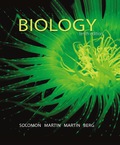
EBK BIOLOGY
10th Edition
ISBN: 8220100474729
Author: Martin
Publisher: Cengage Learning US
expand_more
expand_more
format_list_bulleted
Concept explainers
Question
Chapter 42, Problem 11TYU
Summary Introduction
To describe: The adaptive function of limbic system when an alligator is chasing an individual.
Introduction: Human brain along with the spinal cord makes up the central nervous system. These organs are responsible for integrating incoming information and determining appropriate responses. The human brain consists of the brain stem, thalamus, hypothalamus, cerebellum, and cerebrum. The limbic system is located on either of the thalamus present in the brain.
Expert Solution & Answer
Want to see the full answer?
Check out a sample textbook solution
Students have asked these similar questions
What is the difference between Uniporters, Symporters and Antiporters? Which of these are examples of active transport?
What are coupled transporters?
What are “domains” and how do they aid in protein function?
Chapter 42 Solutions
EBK BIOLOGY
Ch. 42.1 - Prob. 1LOCh. 42.1 - Identify trends in the evolution of invertebrate...Ch. 42.1 - Prob. 1CCh. 42.1 - Prob. 2CCh. 42.1 - What are some advantages of cephalization?Ch. 42.2 - Prob. 3LOCh. 42.2 - Prob. 1CCh. 42.2 - Describe the functions of each component of the...Ch. 42.3 - Prob. 4LOCh. 42.3 - Prob. 1C
Ch. 42.3 - Prob. 2CCh. 42.4 - Prob. 5LOCh. 42.4 - Prob. 6LOCh. 42.4 - Prob. 7LOCh. 42.4 - Prob. 8LOCh. 42.4 - Prob. 9LOCh. 42.4 - Prob. 1CCh. 42.4 - What are two main functions of the vertebrate...Ch. 42.4 - Prob. 3CCh. 42.4 - What role does the limbic system play in emotions?...Ch. 42.4 - In what ways does your success on a biology exam...Ch. 42.5 - Describe the organization of the peripheral...Ch. 42.5 - Prob. 11LOCh. 42.5 - Prob. 1CCh. 42.5 - Prob. 2CCh. 42.6 - Prob. 12LOCh. 42.6 - Prob. 1CCh. 42 - Test your Understanding Know and Comprehend A...Ch. 42 - Which part of the vertebrate brain maintains...Ch. 42 - The main association area in the amphibian brain...Ch. 42 - Prob. 4TYUCh. 42 - Prob. 5TYUCh. 42 - Prob. 6TYUCh. 42 - Prob. 7TYUCh. 42 - Test Your Understanding 8. VISUALIZE Label the...Ch. 42 - Prob. 9TYUCh. 42 - Prob. 10TYUCh. 42 - Prob. 11TYUCh. 42 - EVOLUTION LINK CREB has been shown to be a...Ch. 42 - Prob. 13TYU
Knowledge Booster
Learn more about
Need a deep-dive on the concept behind this application? Look no further. Learn more about this topic, biology and related others by exploring similar questions and additional content below.Similar questions
- What are intrinsically disordered proteins, and how might they be useful for a living system?arrow_forwardWhat are Amyloid Fibrils? What biological functions are these known to perform?arrow_forwardHow do histamine and prostaglandins help in the mobilization of leukocytes to an injury site? What are chemotactic factors? How do they affect inflammation process?arrow_forward
- Compare and contrast neutrophils and macrophages. Describe two ways they are different and two ways they are similar.arrow_forwardDescribe the effects of three cytokines (not involved in the initial inflammation response). What cells release them?arrow_forwardDescribe activation of helper T cells or cytotoxic T cellsarrow_forward
- Compare and contrast MHC 1 and MHC 2. Describe two way they are different and two ways they similar including how they are used in antigen presentation.arrow_forwardDescribe two antimicrobial properties of the skin.arrow_forwardDescribe how the inflammation response starts including the sentinel cells and the chemicals involved. How do pathogens trigger the response particularly in the skin?arrow_forward
- How does complement promote the immune response? Describe three waysarrow_forwardWhich of the following is not a possible mechanism for autoimmunity? Select one: A. Abnormal expression of MHC II molecules in non-antigen-presenting cells B. Activation of polyclonal B cells C. Polymorphism of HLA alleles D. Molecular mimicry E. Release of sequestered antigensarrow_forwardWRITTEN WORK 3: NON-MENDELIAN GENETICS Part A: Complete the Punnett square and calculate for the probability of genotype and phenotype. i i Genotype: Phenotype: 08:55arrow_forward
arrow_back_ios
SEE MORE QUESTIONS
arrow_forward_ios
Recommended textbooks for you
 Biology (MindTap Course List)BiologyISBN:9781337392938Author:Eldra Solomon, Charles Martin, Diana W. Martin, Linda R. BergPublisher:Cengage Learning
Biology (MindTap Course List)BiologyISBN:9781337392938Author:Eldra Solomon, Charles Martin, Diana W. Martin, Linda R. BergPublisher:Cengage Learning Anatomy & PhysiologyBiologyISBN:9781938168130Author:Kelly A. Young, James A. Wise, Peter DeSaix, Dean H. Kruse, Brandon Poe, Eddie Johnson, Jody E. Johnson, Oksana Korol, J. Gordon Betts, Mark WomblePublisher:OpenStax College
Anatomy & PhysiologyBiologyISBN:9781938168130Author:Kelly A. Young, James A. Wise, Peter DeSaix, Dean H. Kruse, Brandon Poe, Eddie Johnson, Jody E. Johnson, Oksana Korol, J. Gordon Betts, Mark WomblePublisher:OpenStax College Biology: The Unity and Diversity of Life (MindTap...BiologyISBN:9781337408332Author:Cecie Starr, Ralph Taggart, Christine Evers, Lisa StarrPublisher:Cengage Learning
Biology: The Unity and Diversity of Life (MindTap...BiologyISBN:9781337408332Author:Cecie Starr, Ralph Taggart, Christine Evers, Lisa StarrPublisher:Cengage Learning Biology: The Dynamic Science (MindTap Course List)BiologyISBN:9781305389892Author:Peter J. Russell, Paul E. Hertz, Beverly McMillanPublisher:Cengage Learning
Biology: The Dynamic Science (MindTap Course List)BiologyISBN:9781305389892Author:Peter J. Russell, Paul E. Hertz, Beverly McMillanPublisher:Cengage Learning Biology 2eBiologyISBN:9781947172517Author:Matthew Douglas, Jung Choi, Mary Ann ClarkPublisher:OpenStax
Biology 2eBiologyISBN:9781947172517Author:Matthew Douglas, Jung Choi, Mary Ann ClarkPublisher:OpenStax

Biology (MindTap Course List)
Biology
ISBN:9781337392938
Author:Eldra Solomon, Charles Martin, Diana W. Martin, Linda R. Berg
Publisher:Cengage Learning

Anatomy & Physiology
Biology
ISBN:9781938168130
Author:Kelly A. Young, James A. Wise, Peter DeSaix, Dean H. Kruse, Brandon Poe, Eddie Johnson, Jody E. Johnson, Oksana Korol, J. Gordon Betts, Mark Womble
Publisher:OpenStax College

Biology: The Unity and Diversity of Life (MindTap...
Biology
ISBN:9781337408332
Author:Cecie Starr, Ralph Taggart, Christine Evers, Lisa Starr
Publisher:Cengage Learning

Biology: The Dynamic Science (MindTap Course List)
Biology
ISBN:9781305389892
Author:Peter J. Russell, Paul E. Hertz, Beverly McMillan
Publisher:Cengage Learning


Biology 2e
Biology
ISBN:9781947172517
Author:Matthew Douglas, Jung Choi, Mary Ann Clark
Publisher:OpenStax